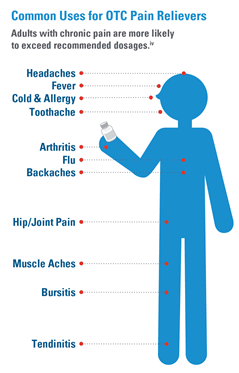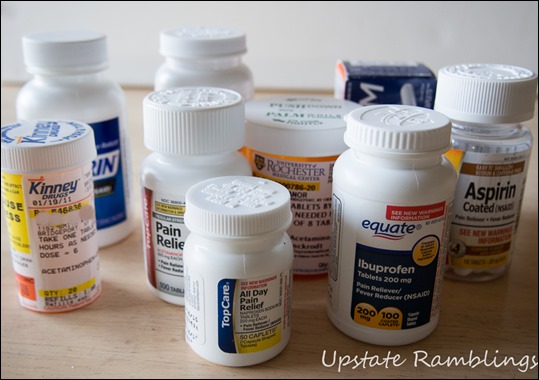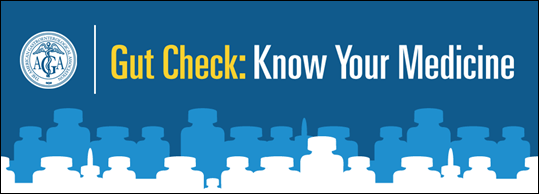I wrote this blog post while participating in a campaign by BOOMboxNetwork.com on behalf the American Gastroenterological Association and received payment for my participation. All opinions stated within are my own.
If your house is like mine you have lots of different kinds of Over the Counter (OTC) pain killers in your medicine cabinet. I checked through mine and found seven different bottles of OTC pain killers, plus some prescriptions left over from various illnesses.
We have aspirin, ibuprofen, acetaminophen, naproxen sodium and various migraine and tension headache formulas which combine some of these ingredients! And I didn’t even look at the cold medicine, many of which also contains a pain killer. So it is no surprise that OTC medicine overdose has become a real problem. It is very important to know what you are taking and talk to a professional about dosage and medicine interaction, because even over the counter medications are dangerous if used incorrectly.
According to the American Gastroenterological Association more than 100,000 people are hospitalized and 17,000 die every year from gastrointestinal bleeding and liver damage due to overdose or overuse of over-the-counter pain medicine ingredients, things that you have in your house right now. I was shocked to learn that acetaminophen is found in over 500 OTC and prescription products, and ibuprofen is in even more! With that many products containing these ingredients it is no wonder that accidental overdoses occur.

Read the label: Don’t assume you remember the dosage of all these different medications! Is it supposed to be 4 hours before you retake it, or 6 hours? Is the safe dosage one pill or two? Make sure you read and follow labels, and know what ingredients are in your medication.
One product at a time: These products have similar effects, and you can’t just mix them.
Talk to a professional about dosage and medicine interaction: If you suffer from chronic pain see a medical professional and find out how you can safely manage your pain.
To learn more visit the Gut Check website and learn how to keep yourself and your family safe and healthy. Check out this video to learn more!




This is a great site-anything to bring more awareness and knowledge about medications and keeping your family safe in my book is a winner–thanks for sharing this site
Great article and great reminders on how to use these meds we take for granted.
Wow…that’s really scary! My mom used to keep a pill bottle with all kinds of different meds in it. She knew what they were, but no one else did! yikes!
This is a great reminder! We always use OTC medication and these are good pointers!
Over dosing on these medications can be dangerous – regular over dose may not kill you but it can damage organs.
This information is very good! And very important.
I’ve been seeing the ads about knowing about your medicine.
I don’t have many in my cabinets, but I know I have children around and need to be very careful.
These are really great tips! I am totally paranoid about taking meds, I always make sure to read labels, you can never be too safe!
Great tips! I know I’ve been guilty of taking more medicine than the bottle recommends when in the throes of a really bad migraine. I also know that I should know better.
Great reminder of using a level head and common sense when taking any type of meds. Just because they are OTC doesn’t make them any less safer.
I actually do try to think this stuff through before I go willy nilly taking multiple things.
Great tips to remember and thanks for the resources. I usually grab whatever is closest in the medicine cabinet and don’t really think about it. Now I’ll have to start paying closer attention to what I’m taking and when and for what purpose!
Great info. I have to admit that prior to becoming a parent, I would “fly blindly” when it came to the meds in my cabinet. “Headache? Oh, just grab any painkiller.” Now, I read the labels on e-ver-y-thing.
What a helpful resource!